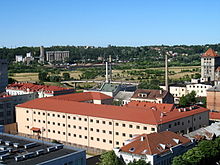
The Ninth Fort is a stronghold in the northern part of Šilainiai elderate, Kaunas, Lithuania. It is a part of the Kaunas Fortress, built in the late 19th century. During the Soviet occupation, the fort was used as a prison and way-station for prisoners being transported to labour camps. After the occupation of Lithuania by Nazi Germany, the fort was used as a place of execution for Jews, captured Soviets, and others.

Kaunas is the second-largest city in Lithuania after Vilnius and an important centre of Lithuanian economic, academic, and cultural life. Kaunas was the largest city and the centre of a county in the Duchy of Trakai of the Grand Duchy of Lithuania and Trakai Palatinate since 1413. In the Russian Empire, it was the capital of the Kaunas Governorate from 1843 to 1915.

The Lithuanian Soviet Socialist Republic, also known as Soviet Lithuania or simply Lithuania, was de facto one of the constituent republics of the Soviet Union between 1940–1941 and 1944–1990. After 1946, its territory and borders mirrored those of today's Republic of Lithuania, with the exception of minor adjustments to its border with Belarus.

The June Uprising was a brief period in the history of Lithuania between the first Soviet occupation and the Nazi occupation in late June 1941. Approximately one year earlier, on June 15, 1940, the Red Army occupied Lithuania and established the unpopular Lithuanian Soviet Socialist Republic, which used political repression and state terrorism to silence its critics and suppress resistance. When Nazi Germany attacked the Soviet Union on June 22, 1941, the Lithuanians rose up, declared renewed independence, and formed the short-lived Provisional Government. Insurgents took two large Lithuanian cities, Kaunas and Vilnius, even before the Wehrmacht arrived. Within a week, the German Army had control of the whole of Lithuania and had killed a stunning number of its citizens. The Lithuanians greeted the Germans as liberators from the repressive Soviet rule and hoped that the Germans would re-establish their independence or at least allow some degree of autonomy. No such support came from the Nazis, who steadily replaced Lithuanian institutions with their own administration. The Reichskommissariat Ostland was established at the end of July 1941. Deprived of any real power, the Provisional Government disbanded itself on August 5.
The Lithuanian Activist Front or LAF was a Lithuanian underground resistance organization established in 1940 after the Soviets occupied Lithuania. Its goal was to free Lithuania and regain its independence. The LAF planned and executed the June uprising and established the short-lived Provisional Government of Lithuania, which disbanded after a few weeks. The Nazi authorities banned the LAF in September 1941. Its role in the three World War II invasions of Lithuania and the massacre of 95% of Lithuania's Jewish population remains ambiguous and the topic of conflicting information and opinion.

Antanas Sniečkus was a Lithuanian communist politician who served as the First Secretary of the Communist Party of Lithuania from 15 August 1940 to 22 January 1974.
The Lithuanian Security Police (LSP), also known as Saugumas, was a local police force that operated in German-occupied Lithuania from 1941 to 1944, in collaboration with the occupational authorities. Collaborating with the Nazi Sipo and SD, the unit was directly subordinate to the German Kripo. The LSP took part in perpetrating the Holocaust in Lithuania, persecuting Polish resistance and communist underground.
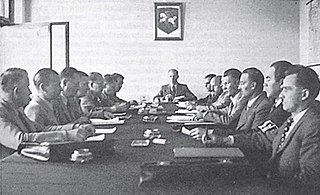
The Provisional Government of Lithuania was an attempted provisional government to form an independent Lithuanian state in the last days of the first Soviet occupation and the first weeks of the German occupation of Lithuania during World War II in 1941.

Kaunas Priest Seminary is the largest seminary in Lithuania serving the Roman Catholic Archdiocese of Kaunas. It is part of the Faculty of Theology of Vytautas Magnus University. Its current rector is Aurelijus Žukauskas. As of 2007, the seminary had 35 students. It traces its history to 1622.
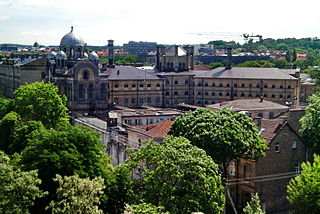
Lukiškės Prison was a prison in the center of Vilnius, Lithuania, near the Lukiškės Square.

The signatories of the Act of Independence of Lithuania were the twenty Lithuanian men who signed the Act of Independence of Lithuania on February 16, 1918. The signatories were elected to the Council of Lithuania by the Vilnius Conference in September 1917 and entrusted with the mission of establishing an independent Lithuanian state. The proclaimed independence was established only in late 1918, after Germany lost World War I and its troops retreated from Lithuanian territory. What followed was a long process of building the state, determining its borders, and gaining international diplomatic recognition. The signatories succeeded in their mission and independent Lithuania survived until the Soviet Union occupied the state on June 15, 1940.
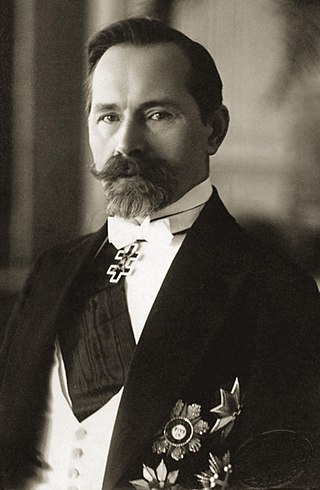
The 1926 Lithuanian coup d'état was a military coup d'état in Lithuania that replaced the democratically elected government with a nationalist regime led by Antanas Smetona. The coup took place on 17 December 1926 and was largely organized by the military; Smetona's role remains the subject of debate. The coup brought the Lithuanian Nationalist Union, the most conservative party at the time, to power. Previously it had been a fairly new and insignificant nationalistic party. By 1926, its membership reached about 2,000 and it had won only three seats in the parliamentary elections. The Lithuanian Christian Democratic Party, the largest party in the Seimas at the time, collaborated with the military and provided constitutional legitimacy to the coup, but accepted no major posts in the new government and withdrew in May 1927. After the military handed power over to the civilian government, it ceased playing a direct role in political life.

Kaunas Fortress is the remains of a fortress complex in Kaunas, Lithuania. It was constructed and renovated between 1882 and 1915 to protect the Russian Empire's western borders, and was designated a "first-class" fortress in 1887. During World War I, the complex was the largest defensive structure in the entire state, occupying 65 km2 (25 sq mi).

Antanas Mackevičius was a Lithuanian Roman Catholic priest who was one of the leaders and initiators of the January Uprising in Lithuania.
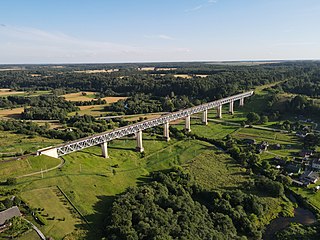
Lyduvėnai is a small town in the Šiluva Eldership, Raseiniai District Municipality, Kaunas County in central Lithuania. The town is 15 km north of Raseiniai and is near the confluence of the Dubysa and Dratvuo rivers. Lyduvėnai is the home of the longest and highest railway bridge in Lithuania, the Lyduvėnai Bridge. The town possesses the eldership's center, has a railway stop, a school, a library, in addition to post. The town's postal code is LT-60046. Lyduvėnai is situated in the Dubysa regional park and has its information center in the town's school. The railway line Šiauliai–Tilžė and the highways to Raseiniai and Šiluva pass through Lyduvėnai. Lyduvėnai is in the Dubysa valley, in contrast to other towns in the Dubysa basin.
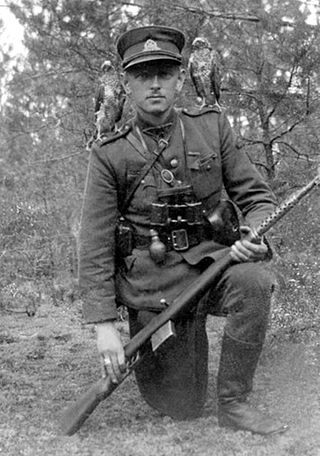
Adolfas Ramanauskas, code name Vanagas , was a prominent Lithuanian partisan and one of the leaders of the Lithuanian resistance. Ramanauskas was working as a teacher under the Nazi administration when Lithuania was re-occupied by the Soviet Union in 1944–45. He joined the anti-Soviet resistance after being pressured by the NKVD to spy on his students, eventually advancing from a platoon commander to the chairman of the Union of Lithuanian Freedom Fighters. Betrayed by a classmate, he was arrested, brutally tortured, and eventually executed. He was the last known partisan commander to be captured.
Vytautas Landsbergis-Žemkalnis was a Lithuanian architect most active in interwar Lithuania (1926–1939). He was the father of Vytautas Landsbergis, the first Lithuanian head of state after independence from the Soviet Union.

Vytautas Bulvičius was a Lithuanian military officer, major of the General Staff, and leader of the anti-Soviet Lithuanian Activist Front (LAF).
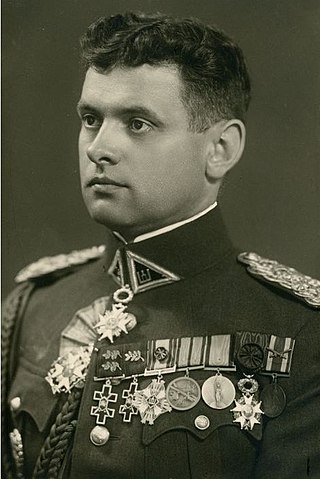
Konstantinas Dulksnys was a Lithuanian colonel of the General Staff, intelligence officer, lecturer.

Stasys Pundzevičius was a Lithuanian division general, lecturer. He held high-ranking military positions in the interwar Lithuania: Chief of the Lithuanian Air Force, Chief of the General Staff, multiple times temporarily was the Chief of the Lithuanian Armed Forces, and was assigned Chief of the Lithuanian Armed Forces by the Provisional Government of Lithuania during the June Uprising in Lithuania.
